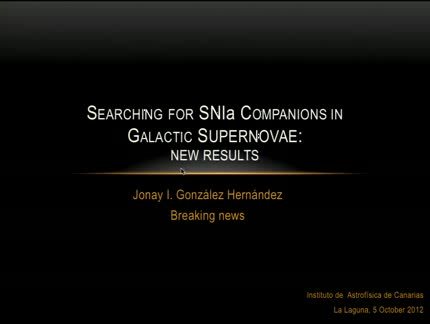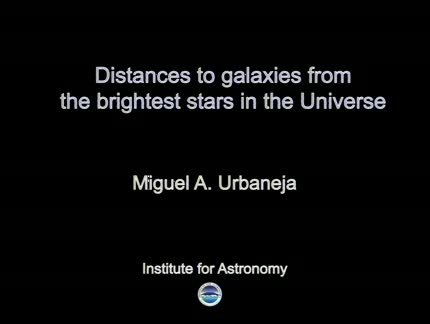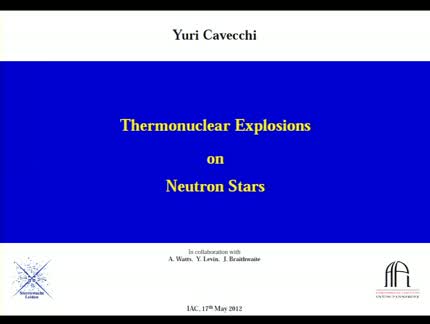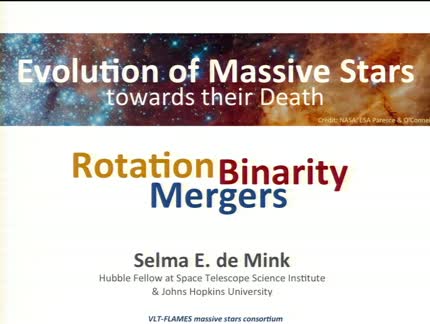Found 132 talks archived in Stars

Abstract
In recent years accurate photometric and spectroscopic observations have
provided sound evidence that Galactic Globular Clusters can not be longer
considered the prototype of Simple Stellar Populations. In this talk we
present the most recent updates concerning the empirical evidence and
discuss the theoretical framework required for interpreting observations.
Current shortcomings in the interpretation of how the multiple stellar
populations formed in a given cluster are also discussed.

Abstract
The basis of stellar population modeling was established around 40 years ago somehow
optimized to the technical facilities and observational data available at that epoch. Since then,
it has been used extensively in astronomy and there has been great improvements relating
their associated ingredients in concordance with the development of more powerful computational
and observational facilities.
However, there has been no similar improvements in the understanding about what is
actually modeling neither in improve the modeling itself to include the current technical advances
to obtain more accurate result in the physical inferences obtained from them.
In this talk I present some advances in the subject of stellar
population modeling and how to take advantage of current facilities to obtain more robust
and accurate inferences from stellar systems at different scales
covering the continuum between fully resolved populations to fully unresolved ones in a unified framework.

Abstract
We report on the discovery of a fourth component in the HD 221356 star system, previously known to be formed by an F8V, slightly metal-poor primary ([Fe/H]= -0.26), and a distant M8V+L3V pair. In our ongoing common proper motion search based on VISTA Hemisphere Survey (VHS) and 2MASS catalogues, we have detected a faint (J = 13.76 ± 0.04 mag) co-moving companion of the F8 star located at a projected distance of ~312 AU. Near-infrared spectroscopy of the new companion indicates an L1±1 spectral type. Using evolutionary models the mass of the new companion is estimated at ~0.08 solar masses, which places the object close to the stellar-substellar borderline. This multiple system provides an interesting example of objects with masses slightly above and below the hydrogen burning mass limit.

Abstract
Type-Ia supernovae (SNIa) are believed to be thermonuclear explosions of accreting carbon-oxygen white dwarfs that reach the Chandrasekhar mass limit of about 1.39 solar masses. However, the nature of the companion star is still under debate, i.e. to be either a dwarf, a sub giant, or a giant star (single-degenerate channel), or another white dwarf (double-degenerate channel). Both channels have been proposed but their relative frequency remains unclear. We have been exploring regions close to the center of supernova remnants of Galactic SNe to search for the companion of these type-Ia SNe. I will show the very recent results we have found in two Galactic type-Ia SNe.

Abstract
I am going to present the new massive and obscured cluster Masgomas-1. This cluster, discovered by our group formed by astronomers from the IAC and CEFCA, is the
first candidate derived from the preliminary version of our systematic search algorithm for obscured (and young) massive clusters, and part of the MASGOMAS project (MAssive Stars in Galactic Obscured MAssive clusterS). In this talk I will present the spectrophotometric observations obtained with LIRIS at William Herschel Telescope (ORM), which allowed the physical characterization of the massive stellar population of Masgomas-1, and the confirmation of the cluster's massive nature
(i.e. Mcl > 10^4 Msun).

Abstract
Measuring distances to galaxies and determining their chemical compositions are two fundamental activities in modern extragalactic astronomy, in that they help characterizing the physical properties of their constituents and their evolutionary status. Ultimately, these measurements lead to stronger constraints on the cosmological parameters of an expanding universe and the history of cosmic chemical enrichment. Both these questions can be tackled afresh with the quantitative analysis of the absorption line spectra of individual massive and luminous, young B- and A-type supergiant stars. A spectroscopic distance determination method, the FGLR, can yield accurate distances up to several Mpc, extending to a local volume where the results can be compared with those obtained from Cepheids and other distance indicators. Moreover, and this being a unique advantage of the FGLR, reddening values and metallicities are simultaneously determined for each individual stellar target. These stellar metallicities are very accurate and can be used to constrain the formation and evolution of galaxies and to assess and overcome the systematic uncertainties of H II region strong-line abundances through a galaxy-by-galaxy comparison. Moreover, stellar spectroscopy provides fundamental complementary abundance information for star forming galaxies on additional atomic species such as iron-group elements. I will present recent results of our on-going efforts to study individual blue supergiant stars in galaxies within and beyond the Local Group based on medium and low resolution optical spectra collected with ESO VLT and the Keck telescopes. The promising perspectives of future work, based on the giant ground-based telescopes of the next generation (E-ELT, TMT) are also discussed.

Abstract
I will review what we know about Type I Bursts (thermonuclear explosions on the surface of accreting Neutron Stars) and burst oscillations (fluctuations in the intensity of the burst lightcurves). I will describe the known problems in burst oscillation models and the various solutions that have been proposed. I will report recent progress made in the case of the pulsar IGR J17480-2446 in the Globular Cluster Terzan 5, where we were able to pin point the most likely mechanism responsible for the oscillations. I will explain whether this might be applicable to the other bursters and discuss future perspectives including current efforts to develop magneto-hydrodynamical simulations of the bursting process.

Abstract
We present the completion of a program to cross-correlate the SDSS Data Release 1 and 2MASS Point Source Catalog in search for extremely red L and T dwarfs. The program was initiated by Metchev and collaborators, who presented the findings on all newly identified T dwarfs in SDSS DR1, and estimated the space density of isolated T0--T8 dwarfs in the solar neighbourhood. In the current work we present most of the L dwarf discoveries. Our red-sensitive (z-J > 2.75 mag) cross-match proves to be efficient in detecting peculiarly red L dwarfs, adding two new ones, including one of the reddest known L dwarfs. Our search also nets a new peculiarly blue L7 dwarf and, surprisingly, two M8 dwarfs. We further broaden our analysis to detect unresolved binary L or T dwarfs through spectral template fitting to all L and T dwarfs presented here and in the earlier work by Metchev and collaborators. We identify nine probable binaries, six of which are new and eight harbour likely T dwarf secondaries. We combine this result with current knowledge of the mass ratio distribution and frequency of substellar companions to estimate an overall space density of 0.005--0.05 pc^{-3} for individual T0--T8 dwarfs.

Abstract

Abstract
Luminous Infrared Galaxies (LIR=10^11-10^12Lsun) have star formation rates in the range of ~20-200Msun/yr. In the local Universe ~50% LIRGs show AGN or AGN/SB composite nuclear activity from optical spectroscopy. We decompose Spitzer/IRS 5-35micron spectra of a complete sample of 50 local (d<75Mpc) LIRGs using SB and AGN clumpy torus model templates. We derive a mid-IR AGN detection rate in our sample of local LIRGs of 50%. We also compare the continuum mid-IR AGN detection with other indicators in the mid-IR, optical and X-rays. We estimate for the first time the AGN bolometric contribution to the IR luminosity of the galaxies in local LIRGs. We find that one-third of local LIRGs have LAGN(bol)/LIR>0.05, with only ~10% having a significant contribution LAGN(bol)/LIR>0.25. This is in line with results of Nardini et al. (2010) that only at LIR>3x10^12Lsun the AGN starts dominating bolometrically the IR luminosity in the majority of the systems.
Upcoming talks
- LIVE NOW: EMO-1: Construyendo un observatorio caseroEnol Matilla BlancoFriday April 19, 2024 - 10:30 GMT+1 (Aula)
- Classical Be stars - Constraining binary interaction physics in massive starsDr. Julia BodensteinerThursday April 25, 2024 - 10:30 GMT+1 (Aula)








